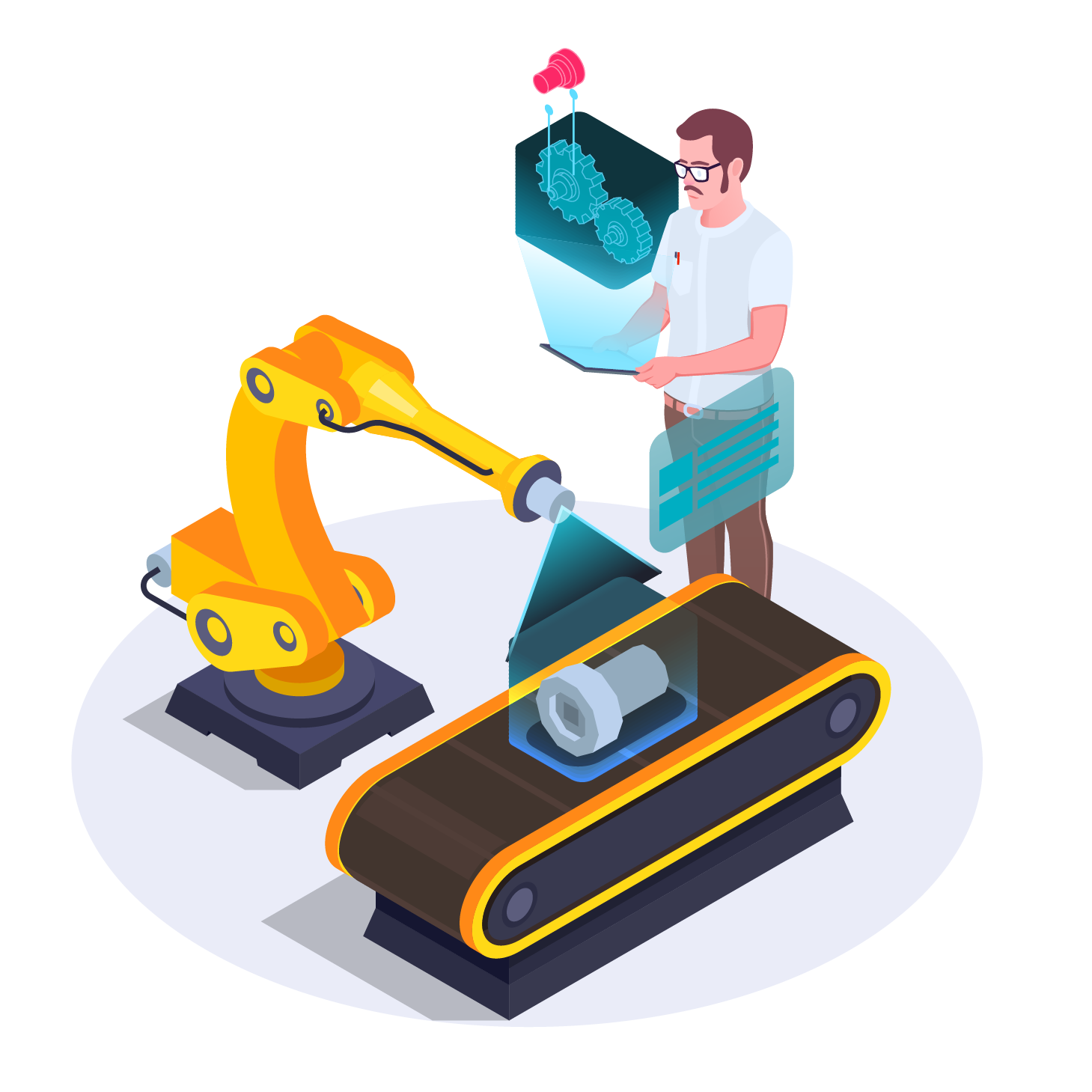Measure
Conversational AI Manufacturing
Data Intelligence™
Real-Time Answers for Modern Factories and Plants
Conversational AI
Turning Factory Questions into Real-Time, Revenue-Boosting Insights
Unplanned downtime already costs the world’s 500 largest manufacturers US $1.4 trillion a year—11 % of total revenue (Siemens, 2024). Yet only 29 % of factories use AI for real‑time decisions and just 24 % have piloted generative AI (Deloitte, 2025). Conversational AI Manufacturing Data Intelligence™ fixes both gaps. Chat with your MES, ERP, SCADA, PLM, or QMS in plain English; On‑the‑Fly BI™ converts the question into just‑in‑time analytics and replies in seconds. Early pilots show ↗ 13 % yield gains and ↘ 204 % audit‑prep time while slashing report backlogs. Think of it as ChatGPT for your factory—but with ISO 27001 security and zero dashboards.


Double Click
How Conversational AI Works
Conversational AI lets people interact with software by typing or speaking naturally. A large‑language model (LLM) interprets intent, fetches data, and returns the answer in prose, tables, or charts.
What Is Conversational AI?
Conversational AI lets people interact with software by typing or speaking naturally. A largelanguage model (LLM) interprets intent, fetches data, and returns the answer in prose, tables, or charts.
Why Factories Need it
Everyday Headache
❌ Reporting Delays
Operators wait hours for analysts to build a report.
❌ Onboarding Drag
New hires spend weeks learning MES screens.
❌ Outdated Insights
Executives review stale KPIs in Monday meetings.
❌ System Overload
Engineers juggle MES, SCADA, QMS, ERP tabs.
Conversational AI Fix
Instant Diagnosis
Operator types “Why is Line 4 slow?”—gets root‑cause chart instantly.
Effortless Metrics
They ask “Show today’s OEE” and skip the tool maze.
Live Reporting
They ask “Last‑hour throughput by plant” mid‑meeting.
Unified Access
One chat window spans every system.
Insights From Your Data, On-Demand
What Is On‑the‑Fly BI™?
On‑the‑Fly BI™ is the real‑time analytics engine behind Conversational AI Manufacturing Data Intelligence™. Imagine the SQL queries, pivot tables, and dashboards your analysts build—but executed only when you ask, against fresh data, and discarded afterward. No cubes, no nightly ETL.

How It Connects to Conversational AI

1. You Ask
"Why did Line 3 scrap spike yesterday?” (Conversational AI parses intent)
2. Translate
Intent becomes a secure, structured query.
3. Analyze
4. Answer
Conversational AI formats the insight and next‑step recommendation.
5. Automate
With one click you can save any answer as a report recipe: set cadence (hourly, daily, weekly) and choose a delivery channel—email, Slack, Google Chat, or Microsoft Teams. On‑the‑Fly BI™ re‑runs the live query at send‑time, guaranteeing fresh numbers every cycle.
Industry Landscape & Stats

Downtime Impact
Automotive plants lose US $2.3 million per hour of unplanned downtime (Siemens, 2024).

Adoption Gap
Only 24 % of manufacturers have deployed generative AI at the facility or network level (Deloitte, 2025).

Market Growth
Gartner expects the conversational AI platform market to reach US $18.4 billion by 2026, a 21.9 % CAGR (Gartner, 2024).

Real world Momentum
Microsoft’s Factory Operations Agent helped Schaeffler diagnose defects across global plants in minutes (Brandom, 2025).
From Theory to Practice
Measure Knowledge Topics
Explore a curated library of essential manufacturing topics. Each entry includes a concise 200-word overview for quick learning and an in-depth 800-word article for deeper insights into standards, systems, and best practices.
Siemens Opcenter MES + Conversational AI: Instant Answers from SFCs, NCs & Traceability
Siemens Opcenter MES houses the answers to nearly every operational question in manufacturing, but traditional BI and reporting methods often delay access to that insight. Leaders may wait hours or days for answers, by which time opportunities to act may have passed. Conversational AI Manufacturing Data Intelligence™ bridges this gap by enabling authorized users to query Opcenter directly in plain English — “Which machines triggered NCs this morning?” — and receive accurate, context-rich answers in seconds. This approach reduces time-to-answer by up to 85% (Siemens Digital Industries Software, 2022) and accelerates corrective actions. In this article, we explore the productivity drag caused by slow root-cause analysis, bottlenecked expertise, and compliance fire drills, then demonstrate how real-world queries can resolve these challenges. An example case study illustrates how a medical device plant cut repeat NC incidents by 40% in one quarter. We conclude with a short FAQ and a call to download EX11, an executive brief on deploying Conversational AI effectively in manufacturing.
Multi-CAD in Teamcenter: how JT makes reviews universal
Traditional BI dashboards are valuable for monitoring KPIs, but they are slow to adapt to unplanned questions from the shop floor. Each new question can trigger a request to IT or a BI developer, often resulting in a days- or weeks-long delay. On-the-Fly BI™ addresses this gap by enabling authorized manufacturing personnel to query live MES, ERP, and quality systems directly in natural language, receiving structured, contextual answers in seconds (Deloitte, 2020; Marr, 2018).
This approach leverages Conversational AI with Retrieval-Augmented Generation (RAG) to securely translate plain-English requests into optimized queries that span multiple data sources, returning answers with operational context—stations, products, shifts, and quality codes—that frontline leaders can immediately act on (Lewis et al., 2020). By bypassing the BI backlog, On-the-Fly BI™ allows teams to diagnose root causes, compare performance across lines, and prepare compliance documents without waiting for a new dashboard or custom report.
In this article, we outline the three main limitations of dashboard-dependent analytics, show practical “Ask This → Get That” use cases, and present an example case study demonstrating measurable productivity gains. We close with an FAQ and a call to download EX12 for a practical playbook on operationalizing Conversational AI across manufacturing networks.
Yield & Scrap – Ask-and-Act Troubleshooting for Faster Quality Wins
In manufacturing, yield and scrap rates directly impact profitability, compliance, and customer satisfaction. Yet quality engineers often wait days for BI teams to compile defect data, delaying corrective actions and increasing waste. Traditional dashboards lack the flexibility to answer unplanned, cross-system questions—such as linking a spike in scrap to a specific machine setting or supplier batch—without adding to BI queues (ASQ, 2023).
On-the-Fly BI™ powered by Conversational AI changes this dynamic by enabling plain-English queries across MES, QMS, ERP, and even vision inspection systems. Engineers can ask, “Show all non-conformance records from the last 48 hours for Product X, sorted by cost impact,” and get an actionable, drillable result in seconds. This real-time visibility empowers same-shift interventions, preventing further defects and enabling immediate process adjustments (Liker & Morgan, 2021).
This article examines the top three causes of yield and scrap troubleshooting delays, provides live operational query examples, and shares a case study from an electronics manufacturer that cut scrap by 22% in one quarter by linking NC detection with rapid root-cause validation. References include fresh industry research, lean manufacturing principles, and practical examples from regulated sectors.
Changeovers & Cycle Time – Find the Hidden Minutes with Chat-Driven Queries
Changeovers and cycle time directly impact schedule adherence and overall equipment effectiveness (OEE), yet root causes of delays are often hidden in siloed systems—MES for routing targets, ERP for labor and tool availability, and shift logs for contextual explanations (Jeston, 2022). Traditional BI dashboards are effective for monitoring performance but fall short when teams need immediate, context-rich answers.
Conversational AI with On-the-Fly BI™ changes this dynamic by letting any authorized user ask questions in plain English—such as “Which OP200 steps ran over standard last week, and what were the recorded reasons?”—and receiving structured answers within seconds. By unifying data from MES, ERP, maintenance, and scheduling systems, the solution eliminates the lag between issue detection and corrective action (McKinsey & Company, 2021).
In this article, we detail three main causes of prolonged changeovers, illustrate real “Ask This → Get That” scenarios, and present an example case study from a high-mix packaging facility that reduced average changeover times by 14% in eight weeks. We close with an FAQ on governance and dashboard coexistence, and a CTA to download EX12 for a step-by-step framework to operationalize conversational analytics for cycle time optimization.
Audit Readiness & Digital Traceability – Compliance in Seconds, Not Weeks
In regulated manufacturing sectors, compliance is non-negotiable, and audit preparation can consume hundreds of hours each year. The average FDA or ISO 13485 audit can require 40–80 labor hours just to assemble required documentation (FDA, 2022). Without integrated data access, quality and operations teams spend days pulling records from MES, ERP, QMS, and LIMS, often risking version control errors that jeopardize compliance.
Conversational AI Manufacturing Data Intelligence™ eliminates these delays by connecting directly to live operational systems and enabling authorized staff to retrieve standards-ready traceability packets with a single question—such as “Generate ISO 13485 compliance records for Batch #X145 including SFC, NC, and operator history.” Answers arrive in seconds, fully structured and linked to the original data source for verification.
This article outlines the three main bottlenecks in audit preparation, provides real-world “Ask This → Get That” examples, and presents an example case study from a medical device manufacturer that cut audit prep time by 92% while improving accuracy. We close with an FAQ on data integrity and standards alignment, plus a CTA for downloading EX11 to guide implementation of Conversational AI for compliance readiness.
Cross-Site Benchmarking & SOP Harvesting – Scaling Excellence Across the Enterprise
In global manufacturing enterprises, operational excellence often develops unevenly—one site perfects a setup sequence that cuts changeover by 15%, while another site struggles with downtime in the same process. Without systematic cross-site benchmarking, these improvements remain siloed, costing organizations millions in missed efficiency gains (Deloitte, 2020).
Traditional benchmarking programs rely on quarterly reviews or central data teams, which means by the time insights are shared, market conditions and product mixes may have shifted. Conversational AI with On-the-Fly BI™ transforms this process by allowing plant managers, engineers, and continuous improvement teams to compare live performance metrics and SOP adherence across multiple sites instantly.
By unifying MES, ERP, and quality system data, teams can ask natural-language questions like “Which site achieved the lowest average cycle time for Product Family A last month, and what SOP deviations did they implement?” The system returns structured comparisons and linked SOP documents, enabling quick adoption at underperforming sites.
This article examines the three key barriers to effective SOP harvesting, provides live query examples, and includes a case study showing a global automotive supplier increasing overall equipment effectiveness (OEE) by 7% in a single quarter through AI-enabled benchmarking.
Closed Loop Manufacturing – Continuous Improvement at Scale
Most manufacturers run improvement projects in bursts. Gains erode because lessons do not flow back into design, planning, or daily work. Closed‑loop manufacturing fixes this by connecting data from design to production and back again so each detection triggers analysis, action, and verification, then updates the standard for the next run. That loop requires two foundations. First, a digital thread that links product and process data across PLM, MES, maintenance, and quality systems so information moves with the workpiece (NIST, 2022; Siemens Digital Industries Software, 2025). Second, a practical way for people to use the thread without tickets or delays. Conversational AI with On‑the‑Fly BI™ provides that interface. A supervisor can ask “Which non‑conformance events were linked to this routing step last week” and get the answer with context in seconds.
This article covers two loops that pay off fast. The quality loop detects a non‑conformance (NC), explains root cause, applies a corrective action, and verifies the result. The efficiency loop reduces cycle time, proves the change, and updates standard work across lines and sites. We show examples of plain‑English queries, a cross‑site case study, and guidance on governance. We also map where standards such as ISA‑95 and SPC practices fit so your loop is both fast and reliable (ISA, 2025; Montgomery, 2019).
What Conversational AI Can and Cannot Do in Manufacturing (and When to Add Predictive, IIoT, and Computer Vision)
Conversational AI is changing how manufacturers access data by turning plain‑English questions into instant answers from MES, ERP, QMS, and historian systems. It excels at retrieval, summarization, cross‑system correlation, and on‑the‑fly reporting, which speeds root‑cause analysis, audit preparation, and daily performance management. These strengths make it a powerful “front door” to operational data and decision support (Stanford HAI, 2024). Yet Conversational AI is not a control system, a predictive maintenance model, or a substitute for validated measurements. It can misinterpret ambiguous prompts, generate incorrect answers when sources are insufficient, and should be bounded by governance, testing, and human‑in‑the‑loop review (NIST, 2023; ISO/IEC, 2023).
This article draws a clear line between what Conversational AI can do today—retrieve and contextualize records, produce traceability packets, compare lines and shifts, and narrate insights—and what it cannot do alone—deterministically control machines, guarantee statistical forecasts, or replace sensors and cameras. We offer step‑by‑step “Ask this → Get that” examples with deliberate handoffs: to predictive models for remaining useful life, to IIoT platforms for real‑time telemetry, and to computer vision for visual inspection and safety analytics (Accenture, 2024; WEF, 2025). A short case study shows how a manufacturer combined these capabilities, and an FAQ addresses accuracy, security, and validation.
How‑To / Best Practices
1. Connect securely
Use pre‑built connectors for Siemens Opcenter™, SAP S/4HANA™, Ignition™, and Teamcenter™.
2. Define entities
3. Start with questions, not dashboards
4. Pilot one line first
5. Validate answers
Compare Conversational AI Manufacturing Data Intelligence™ output to existing reports for two weeks; tune synonyms and thresholds.
6. Roll out across shifts
7. Measure success

Case Studies & Examples

Semiconductor Fab – Yield Boost
Problem – Trace defects exceeded 5 ppm; root‑cause digging took 3 days.
Approach – Connected Siemens Opcenter™ and SCADA tags to Conversational AI Manufacturing Data Intelligence™; operators asked “What shifted before defect spike?”
Result – Identified coolant‑flow anomaly in < 90 s; ↗ 13 % yield in two weeks.

Medical Device Plant – Audit Prep
Problem – FDA traceability packet generation consumed 120 person‑hours per audit.
Approach – Used Conversational AI Manufacturing Data Intelligence™ to generate device‑history records on demand.
Result – ↘ 204 % audit‑prep effort; auditors accepted digital packet on first submission.

Food & Bev – Predictive Maintenance
Problem – Filler micro‑stops caused 2 h/week downtime.
Approach – Integrated vibration sensors; maintenance techs asked via chat which
bearings would fail next week.
Result – ↘ 9 % unplanned downtime, saving US $1.1 M/year.
Frequently Asked Questions
- What data sources can Conversational AI Manufacturing Data Intelligence™ connect to?
Any SQL‑based or REST‑accessible MES, ERP, SCADA, PLM, or QMS. Pre‑built connectors ship for Siemens Opcenter™, SAP S/4HANA™, Ignition™, and Teamcenter™—custom sources plug in via our SDK. - Can a one‑off answer become a recurring report?
Yes—click Save as Report, choose a cadence (hourly, daily, weekly) and a delivery channel (email, Slack, Google Chat, or Microsoft Teams). On‑the‑Fly BI™ reruns the live query at send‑time, so numbers are always current. - How long does initial deployment take?
Most plants start asking live questions in under one business day per connected data source thanks to schema autodetect and no‑code connectors. - Does this replace my existing BI dashboards?
Think of it as a conversational overlay. Dashboards stay for monitoring; Conversational AI Manufacturing Data Intelligence™ answers the ad‑hoc “why” and “what if” questions dashboards can’t anticipate. - How is my data secured?
We operate in ISO 27001‑certified data centers, enforce single‑tenant storage, and support SSO with role‑based access controls. No data is used for model training.
References
Abdelaal, M. (2024). AI in Manufacturing: Market Analysis & Opportunities (arXiv:2407.05426). https://arxiv.org/abs/2407.05426
This source is relevant if you want a concise synthesis of where AI is actually being applied in factories and what’s blocking wider usage. You’ll find a literature review with market sizing, adoption patterns, and practical considerations across discrete and process industries. Two takeaways we used: adoption is uneven and concentrated in a few high-value use cases; success hinges on unifying siloed data rather than model choice alone.
Brandom, R. (2025, February 24). AI Assistants Join the Factory Floor. WIRED. https://www.wired.com/story/ai-swaps-desk-work-for-the-factory-floor
This article is useful for seeing real plants put conversational agents to work, not just lab demos. You’ll find reporting on Schaeffler and others using assistants to surface live manufacturing data and speed diagnoses. Two takeaways we used: shopfloor acceptance rises when answers are grounded in live systems; conversational interfaces shorten the time from question to corrective action.
Deloitte. (2025, May 1). 2025 Smart Manufacturing and Operations Survey. https://www.deloitte.com/us/en/insights/industry/manufacturing-industrial-products/2025-smart-manufacturing-survey.html
This is the benchmarking study to read if you want hard numbers on adoption and talent gaps. You’ll find executive-level stats on genAI pilots, scaling barriers, and expected ROI horizons. Two takeaways we used: only about a quarter of manufacturers have deployed genAI at scale; skill shortages remain a top obstacle to realizing value.
Gartner. (2024, April 3). Market Guide for Conversational AI Solutions. https://www.genesys.com/resources/market-guide-for-conversational-ai-solutions
This guide is relevant for understanding how analysts define the conversational AI solution landscape and what capabilities enterprises should require. You’ll find a framework that covers NLU, orchestration, connectors, guardrails, and buying considerations for enterprise deployments (registration required via an authorized distributor). Two takeaways we used: platforms must orchestrate queries across multiple systems; governance and security controls are first-class requirements in industrial settings.
McKinsey. (2025). AI in the Workplace: 2025 Report.
https://www.mckinsey.com/capabilities/mckinsey-digital/our-insights/superagency-in-the-workplace-empowering-people-to-unlock-ais-full-potential-at-work This report is relevant if you want to understand how AI assistants change day-to-day work and where productivity actually shows up. You’ll find a large-scale survey and case analyses covering task patterns, adoption hurdles, and the “superagency” model for empowering employees. Two takeaways we used: timetoinsight drives most of the measurable gains; assistants deliver outsized value when integrated with core enterprise systems rather than used in isolation.
Mok, A. (2025, May 13). How AI and Robotics Prevent Breakdowns in Factories. Business Insider. https://www.businessinsider.com/artificial-intelligence-robotics-predictive-maintenance-manufacturing-factory-solutions-2025-5 This piece is helpful if you want an accessible primer on predictive maintenance and downtime prevention with AI. You’ll find case vignettes that connect sensor data, anomaly detection, and decision workflows to concrete savings. Two takeaways we used: predictive maintenance delivers quick wins when paired with operator workflows; even modest downtime reductions compound into seven-figure savings annually.
Siemens AG. (2024). The True Cost of Downtime (White paper). https://assets.new.siemens.com/siemens/assets/api/uuid:1b43afb5-2d07-47f7-9eb7-893fe7d0bc59/TCOD-2024_original.pdf
Read this to quantify why speed to insight matters in manufacturing. You’ll find per-hour loss figures by sector and a global estimate of annual downtime costs with methodology notes. Two takeaways we used: unplanned downtime can exceed US$2M per hour in some verticals; total annual impact exceeds a trillion dollars—justifying real-time, question-driven analytics.
























